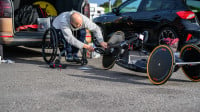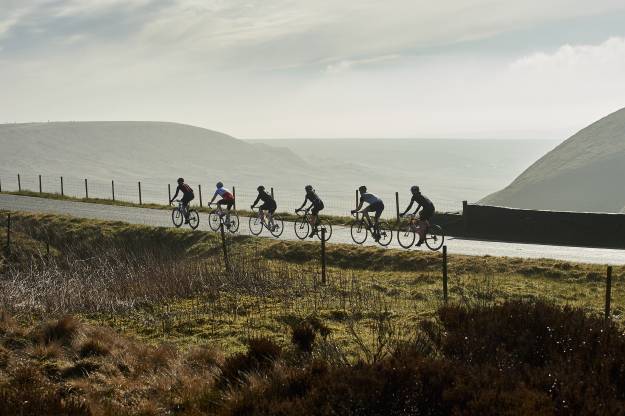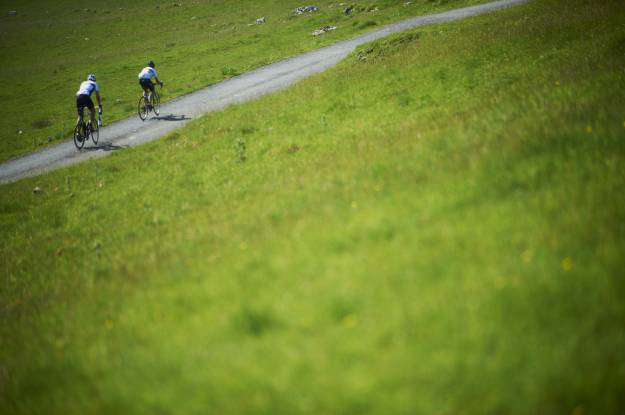Knowledge Level: Intermediate
Trail centres are understandably popular with many mountain bikers. With their all-weather surfaces, way-marked routes and trailhead facilities, they provide convenient locations to get your off-road riding thrills. However there is an amazing network of byways, bridleways and lanes that can be explored on two wheels, opening up the opportunity for some true wilderness riding and exploration.
Remoteness, such as being more than 30 minutes walk from where an ambulance could access, the weather conditions and the terrain all contribute to what wilderness is but, whether you’re tackling bridleways in the Peak District or Snowdon in North Wales, ride safe, take some simple and sensible precaution and follow this advice to put the mountains back into mountain biking.
Safety first
Along with carrying the correct kit, planning a suitable route and riding according to your fitness and skill level, a number of other steps can be taken to make wilderness riding safe.
Try to ride with at least one other person and preferably in a group. Always have a late-back procedure in place which should include; letting someone know the route you’re intending to ride, how long it should take, where you’ve paraked and any alternative routes you might possibly take. Arrange to check-in with them once you’re finished make them aware of what time they should try to contact you and then the emergency services, if they don’t hear from you. There are now mobile phone apps and GPS trackers avaiable that allow your ride to be traced online but these should be an additional layer of security and not relied upon 100%.
Always have a fully charged mobile phone with you and make sure you’re not draining its battery by using its GPS for navigation or recording ride stats. Keep your phone in a fully waterproof case and protect it in the middle of your bag where it won’t be damaged in a fall. Register your mobile to be able to text message the emergency services as, in remote areas, there sometimes won’t be a strong enough signal to make a call but a text will often go. Have an I.C.E (in case of emergency) stored in your phone and make sure the security lock is turned off. In an emergency there are several numbers you can call. Watch this video that explains what your options are.
A basic knowledge of First Aid should be a priority for all mountain bikers and is especially important when riding in remote locations. Certain courses are geared towards outdoors activities, including mountain biking, and attending one could genuinely be a life saver.
Always support the local Mountain Rescue service wherever you’re riding. These are the guys who will probably be the first on the scene if something does go wrong and, as well as all being unpaid volunteers, they rely totally on fundraising and donations to deliver the amazing service they offer. Whenever you see a collection box, get into the habit of always dropping a pound or two in and see it as a very reasonably priced insurance policy.
Pay close attention to the weather forecast and dress accordingly. If necessary alter or shorten your route. For most of the upland areas in Britain, the Mountain Weather Information Service provides accurate and up to date forecasts but always check local forescasts and don’t rely on any single one. No forecast is 100% certain, so always be prepared for the weather to suddenly change for the worse. Also take into account the days leading up to your ride. If its been especially wet, the trails may be heavier going and your progress considerably slower.
Unlike at a trail centre where the trails are built to be ridden, public rights of way, natural and wilderness trails are not. If you have any doubts about what’s around the next corner or whether you have the skills to ride a particular section, get off and walk.
Where can I ride and planning your route
In England and Wales, you have the right to ride on the following public rights of way:
Bridleways
Byways open to all traffic
Restricted byways
Some rights of way have special agreements in place. An example is Snowdon, on which certain routes up the mountain are open to cyclists only at specfic times of day and of the year. If you have any doubts about your planned route, check with a local contact such as a cycle shop.
You may also ride on the following:
‘Routes with other public access’ – the Ordnance Survey term for ‘white roads’ or ‘green lanes’
Unsurfaced roads
Forestry Commission stone tracks
Some unsurfaced Forestry Commission tracks
Forestry Commission mountain bike trails
Cyclepaths and cycletracks
Some canal towpaths
There are a number of bodies who are lobbying for increased access rights for mountain bikers in England and Wales as the current rights of way distinction between bridleways and footpaths was made long before mountain biking even existed. The exact intricacies of the law are complex and vague but, right now, you should assume that you don’t have the right to ride on footpaths and shouldn’t do so.
In Scotland, the Land Reform (Scotland) Act 2003 gave you some of the best access rights in the world. You have the right to be on most land and inland water for recreation, education and going from place to place, providing you act responsibly. Here are further details of the Scottish Outdoor Access Code. This access may also be being introduced into Wales soon.
When planning a wilderness route, don’t underestimate the amount of time rough terrain can take to cover. Although 20km may be a short blast at a trail centre, throw in some unrideable climbs, heavy bogs or tricky navigation and it can easily turn into an all day epic. On genuine wilderness terrain, allow plenty of time for your ride. Start as early as possible and always try to plan finishing with adequate time before dark unless you’re planning on including some night riding. It’s always wise to carry lights just in case, especially if you know you’ve got some road sections on your route.
Make as much use as possible of guidebooks, the internet and local knowledge to gather as much information as possible about the trails you intend to ride. When planning routes, always factor in escape routes that can quickly get you off high ground or provide a shorter route home should the weather deteriorate or you find you’ve bitten off more than you can chew.
Apply common sense and don’t ride trails if you’re obviously causing significant erosion or damage. Stick to already worn lines and don’t create new ones, even if this means riding through a puddle. This especially applies to sensitive wilderness terrain and you should always be looking to minimise the impact of your riding.
Essential kit
When riding in remote areas it’s vital that your bike is well maintained and functioning correctly. At best, mechanical issues that should have been noticed and addressed before riding are annoying and slow up the group but, in poor weather conditions, they can easily lead to a serious situation. Get into the habit of always performing a pre-ride bike check to prevent this from happening.
Self-reliance is key to safe riding in the wilderness so make sure you are carrying the following:
Fully charged mobile phone
First Aid kit
Foil space blanket or group shelter
Food and drink for the expected duration of the ride plus some extra
Small amount of money
Multi-tool with chain-tool and, if riding tubeless, pliers for removing valve
Missing link/power Link
Spare inner tubes and puncture repair kit
Emergency tyre boot (old toothpaste tube cut into sections is ideal)
Pump
Spare mech hanger
Zip-ties
Small bottle of lube
Map of area (OS 1:50,000 or 1:25,000)
Compass
Along with your regular riding clothing, including a quality wicking baselayer, you should always carry a fully waterproof jacket, a spare baselayer, a warm hat and gloves. Arm-warmers and knee warmers are also great flexible items of clothing to throw in your backpack.
Even in the summer, it’s very easy to become chilled in the hills if you have to stop for any length of time, especially if you’ve been working hard and sweating beforehand.
Leave your stiff carbon soled cross-country shoes at home and opt for slightly more flexible shoes with plenty of grip and decent toe-bumpers. Wilderness rides often involve significant “hike your bike” sections and you’ll be grateful of more forgiving, robust and grippier footwear.
Make sure you have plenty of warm and dry clothes and a towel laid out and ready in your car for when you finish.
Skills and techniques
The most important skill when wilderness riding is knowing how to use the map and compass you’re carrying. Don’t rely on electronic devices, it’s all to easy for batteries to fail or for them to die in the wet. Check regularly that you are where you think you are on the map. If the clouds come down, even heavily used bridleways can be easy to lose, especially if moving quickly downhill. Skills such as taking a bearing off a map and following it, using features on the ground as handrails and relating distance travelled to the map are all basic essentials. If you’re not confident with map and compass, consider taking a course. Finally, if you’re riding a steel framed bike, remember that it can affect your compass, so take readings away from it or pass navigation duties to someone riding alloy or carbon.
Riding skills that you’ve learned in trail centres all apply to wilderness rides and, if you need a reminder of some key techniques, there are some great videos. Don’t forget that with extra kit, clothing, water and fuel in your pack, your balance and weighting on your bike might have altered and you may have to adjust fork and shock settings.
For all-day wilderness rides, good pacing is essential. Always try to ride within yourself and, especially on non-technical terrain such as long draggy fire road climbs, save your energy and don’t push too hard. Ride efficiently and only use your top-end strength and power when the trail genuinely demands it. If you use heart rate on the road and are aware of your training zones, trying to ride predominately in Zones 1-2, saving bursts in 3-4 for steep climbs, is ideal for pacing big mountain days.
Eat and drink regularly, adopting a little and often strategy right from the start of the ride. Take on food every 30 minutes and don’t wait until you feel hungry or thirsty. You’re not eating and drinking for that moment but for 5-10 miles down the trail. This advice from the Great Britain Cycling Team nutritionists, applies equally to a day’s mountain biking as it does a sportive.
If planning your own wilderness ride is too daunting then why not engage a qualified Mountain Bike Leader to take you out the first time to show you great trails and take you safely round a great route.
If you are a keen mountain biker and want to share your passion for mountain biking with others as a qualified leader, check out British Cycling's Mountain Bike Leadership courses.










